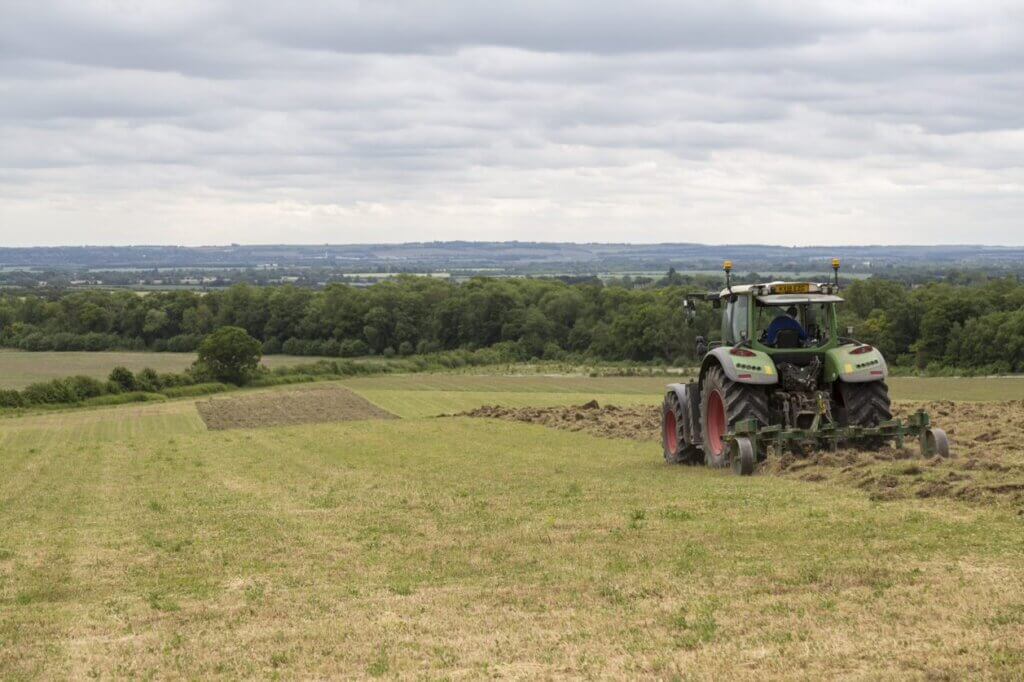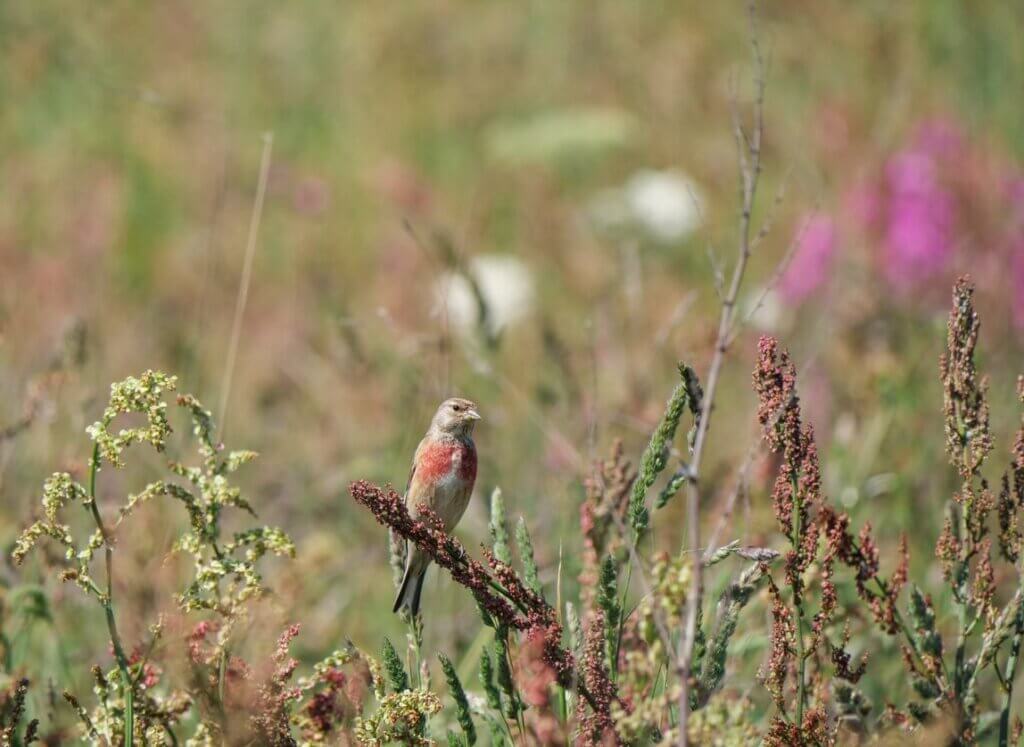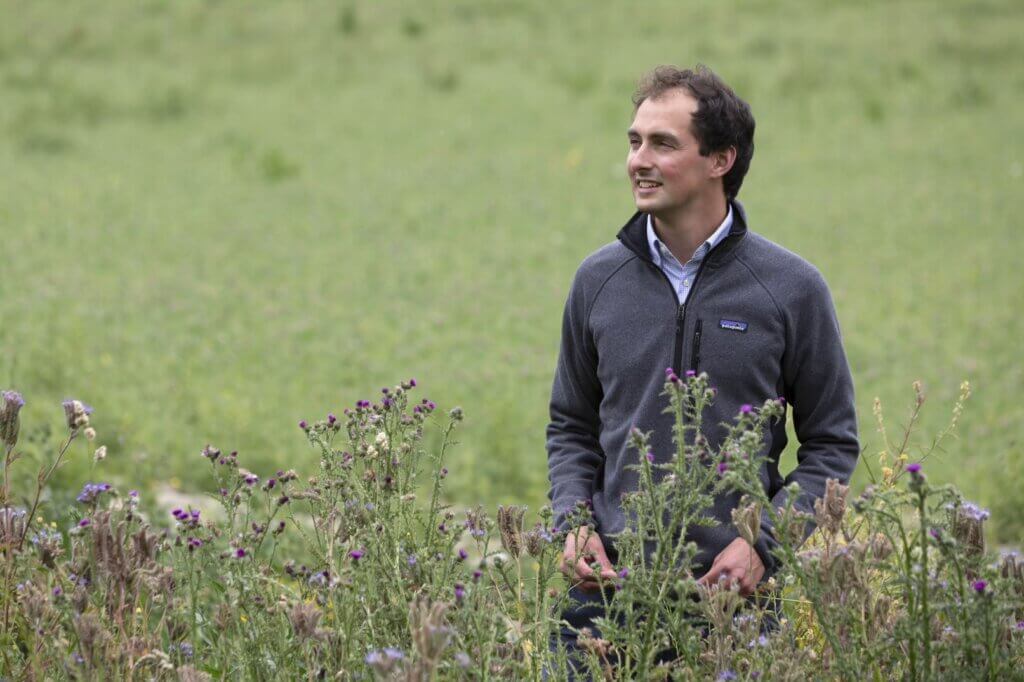Farming for nature pays off for Wimpole
- Rare farmland bird numbers double in six years
- Invertebrate numbers increase by over a third in 13 years
- Farmland sequesters high levels of carbon while producing food and making a profit

Nature and soil health are flourishing at the National Trust’s Wimpole Home Farm near Cambridge according to the results of a full ‘health-check’ into its biodiversity, carbon levels and levels of public accessibility.
The results, announced as the landmark Agriculture Bill starts its next crucial stage in the House of Lords today, show increases in the numbers of breeding pairs of rare farmland birds, invertebrates and how the land is a significant sequester of carbon.
The organic farm has been focusing on nature friendly, sustainable farming methods for the past 12 years to reflect the conservation charity’s goals for farming models which are good for nature, deliver public benefit and which are profitable.
Nationally, numbers of farmland birds have declined by 54 per cent since 1970, the distribution of bees and hoverflies declined by 31 per cent between 2009 and 2014 and it is estimated that soil degradation in England and Wales costs the economy £1.2 billion a year.
The 589 hectare (1,419 acre) mixed livestock and arable farm, which is the only lowland farm run in-hand by the conservation charity, conducted in-depth surveys over two years into farmland birds, invertebrates and soil health.
Key results included:
- the doubling in numbers of breeding pairs of rare skylarks and linnets in six years which are good indicators of a healthy ecosystem
- a 38 per cent increase in invertebrate numbers over 13 years to include the recording of 95 rare and protected species, vital for pollinating crops and preying on pests
- a total carbon balance of -2,260 tonnes of CO2 per year achieved through the amount of organic matter in the soil which soaks up carbon, the number of trees and grown out hedges

As for public goods, in terms of access for the public, Wimpole also has over 40km of public rights of way and permissive paths which are enjoyed by over 350,000 visitors a year.
As a business, the farm is also returning a healthy profit.
Last year, production levels across 369 hectares (912 acres) of the arable farm reached impressive levels for an organic farming system with last year’s harvests resulting in 142 tonnes of wheat – enough to make 200,000 loaves of bread, or over four million scones – 123 tonnes of organic barley – equivalent to what’s needed to make nearly 1.5million pints of beer and 126 tonnes of organic oats – equivalent to over 2.5 million bowls of porridge.
For 2019, this resulted in £294,617 income, £117,588 profit for the farm (including subsidy payments).

Callum Weir farm manager at Wimpole said: “Many of the increases we recorded in the surveys are down to the combination of organic farming methods in the fields and the mosaic of margins, hedges and habitats that surround each field.
That is not to say that organic farming is the only way to farm with nature. There are great examples of farmers across the UK who aren’t organic, but are still delivering massive benefits to the environment. Like many farmers, we dedicate areas of Wimpole to help biodiversity. For example, we sow a variety of plants including phacelia which has purpley blue flowers, clover and sainfoin, with its bright pink flowers which flower from early April right through to October. These attract and support pollinators and insects which have a vital role in the ecosystem.
The survey results are vital to understanding how our holistic approach to farming at Wimpole is working. We want to farm sustainably at the same time as being a truly viable business and it’s fantastic to see how nature friendly farming and a profitable farm business, can go hand in hand.”.
Mark Harold, Director of Land and Nature at the National Trust said: “Sustainable, productive and profitable farming is underpinned by a healthy environment.
Coronavirus has shown how important it is to have a resilient food and farming system. We know that climate change and sustainability pose the greatest threats to food security, as this year’s flooding and now drought have shown.
The Agriculture Bill – and the principle of public money for public goods at its heart – is an opportunity to deliver this.
At the Trust we are working to demonstrate that sustainable farming does work and that it is profitable.
We have taken the risks, experimented and want to share our learnings with others. At Wimpole we’ve had to overcome particular challenges such as soil degradation, decreasing returns from farming and declines in farmland wildlife.
With a focus on sustainable land management, wildlife and soil health can recover quicker than we might think.
The story at Wimpole paints one of hope and optimism – and the Government’s forthcoming ‘environmental land management scheme’ will be crucial to replicating this across the farming industry, as will the new Agriculture Bill in prioritising government support for this scheme. Together, these two mechanisms will ensure all farms have a sustainable future which will be good for the environment, good for farm businesses and good for people.
Today, the Agriculture Bill starts its next stage in the House of Lords. It’s vital that its ambition and key public goods principles aren’t weakened. We also mustn’t see progress at home on sustainability undermined by food imports that don’t meet our standards: the Bill should therefore be amended to provide safeguards against this.”
Survey results in detail
To fully understand the impact of 12 years of organic farming on the environment, the team carried out surveys into rare farmland birds, invertebrates and conducted an in-depth study into carbon sequestration.
Key findings from the farmland bird survey conducted across half the farm revealed that since 2013:
- Numbers of rare skylarks have increased by 75 per cent, from 12 to 21 pairs
- Number of rare linnets have doubled from three to seven pairs
- Wimpole is one of the most important populations of the rare corn bunting in Cambridgeshire with between five and eight pairs breeding each year.
- The farm provides winter feeding habitat for at least nine rare bird species – grey partridge, lapwing, linnet, skylark, starling, yellowhammer, woodcock, hen harrier, fieldfare
This included 95 rare species with formal conservation status including Bombus Ruderatus – the large garden bumblebee and Tyria Jacobaeae – the cinnabar moth. 75 species of bee, 49 species of wasps, 46 species of hoverflies and 22 types of butterflies were recorded. Other key results from last year included:
- A 150 per cent increase in Hymonptera (wasps, bees, ants)
- A 190 per cent increase in the number of rare invertebrate species including the nationally scarce (NS) Tumbling Flower Beeting (Mordellistena variegate), the small heath butterfly (high on the Butterfly Conservation Priority List) and the (NS) Slender-horned Leatherback
- A 30 per cent increase in the number of butterfly species including the silver washed fritillary and marbled white.
- The organic field margins support on average 30 per cent more invertebrates then conventional field margins.
Callum continued: “We were so pleased by the results of the study. It was great to see that our margins, so rich in wildlife, bordering productive farmland. This gave me real hope that with the right support, farmers can help address biodiversity losses and play our part with tackling the climate crisis.”.
The team used the Farm Carbon Cutting Toolkit, a recognised carbon measure by the farming industry, to conduct a full carbon analysis across the whole estate to include the farmland, parkland and woodland.
Thanks to the team’s holistic approach to farming on the estate, incorporating soil management, habitats and tree planting/woodland management, the land is a significant sequester of carbon, with a total carbon balance of -2,260 tonnes of CO2 per year.
Callum explains: “When you think that an economy class return flight from London to New York emits an estimated 0.67 tonnes of CO2 per passenger, this is really significant.”.
Over the last 12 years, by far the biggest sequester of carbon is the increase in soil organic matter (SOM).
This has been achieved by applying agroecological principles to the arable farmland which includes reducing cultivation, cover cropping, integrating livestock, utilising habitats and stewardship and embracing technology.
“Trees were a significant sequester or carbon on the estate, however the main belts and blocks of woodlands on the estate are reaching maturity and will soon stop sequestering carbon (but these old trees remain very valuable to biodiversity). However, we’ve addressed this by planting 1,000 parkland trees over the past 10 years which will help with carbon capture and biodiversity.
We recognise that our livestock are a large emitter of carbon. But, they are the perfect tool to manage our Grade 1 listed parkland and the traditional hay meadows.
If we were to plough up the parkland and convert it to arable, this would release 50,000 tonnes of CO2e from this carbon sink – equivalent to 100,000 return flights to New York City (for individual people or 416 full 747 aeroplanes). This demonstrates the value of livestock in the carbon cycle, and the benefits of grass fed meat. If meat is produced in the right way and consumed in the right amounts, it can be sustainable.”
-Ends-
[registration_form]
wrt “grown out hedges” we’re most of the way through laying all ours for s second time – is this a good thing?
Some good news atlast. We need a good percentage of our farms to be like this in order to start turning the tide the other way.
I would be interested to know if they control numbers of predators.
Would be nice to see the increases without any killing of our wildlife.
I can’t find a link to the actual report anywhere, can you Mark.
I won’t get over-excited until I’ve seen the primary source.
Tim – it was a press release with a load of other info attached. You would have to ask the National Trust I’m afraid.
I’ve tried to find it on their website with no success.
I emailed the Press Office on 11th asking for a copy of the report. Not had an answer. Not a good look.
An organic cereal yield of a smidge over 1t/h doesn’t seem enough to be called “impressive” – organic wheat is capable of over 4t/ha. I can’t help feeling some info is missing – perhaps not all the 369ha arable was under cereals?
Those cereal yields seem incredibly low (just over a tonne per hectare) -are they correct ?
Ave Uk yields for wheat =7 tonnes/hectare
barley = 5.6tonnes and oats= 5 tonnes .
How do these yields compare to your Mellow yellow friend down the road (assuming he rotates oilseed rape with cereals)?
Gary – these are organic yields, that’s why.
They still seem low even for organic.
As Filbert says probably not all arable hectares are growing cereals ,some down as short term grass/clover leys to build up fertility.
Good PR (or spin) to put it in terms of loaves /bowls of porridge etc.
There must be some non-cereal area included but even if it was 25-50% as short-term ley the avg cereal yield is still v low even for organic. But who needs four million scones?
Filbert – NT say that the yields were;
Wheat – 5.16 tonnes/hectare
Barley – 3.87 t/ha
Oats – 5.09 t/ha
but that would appear to account for 84ha (out of 369ha) so I am rather confused too.
Gary – NT say that the yields were;
Wheat – 5.16 tonnes/hectare
Barley – 3.87 t/ha
Oats – 5.09 t/ha
but that would appear to account for 84ha (out of 369ha) so I am rather confused too.
Thank you for that information. Those yields look pretty good for organic but it is confusing given the total arable acreage.
Normally here in Devon those scones would be gone in a trice.
Know nothing about this stuff at all. Would it be relevant to compare the farms yield to that of Hope farm also in Cambs?
That is assuming that Hope is organic. I would hope it was since we donated to it all those years ago.
Paul – Hope Farm was not and is not organic (as was said at the time) because it stands as a demonstration farm for ‘conventional’ farmers. Cereal yields much higher on Hope Farm.
PS I donated too.
This is good to see the efforts paying off. Now it’s been shown to work the challenge is to ensure other farms follow this example accordingly.
Presumably the farm made a profit because it was able to charge premium prices for it’s organic produce. With millions of people now reliant on food banks because they can’t afford to put food on the table organic farming will only make the problem worse unless it can compete with intensive conventional farming on price. Obviously the ideal solution would be to ensure that everyone is able to afford quality organic food, but until that happens (and people are prepared to pay extra for it) organic will remain as a niche market, and people buying it may be able to feel good but it won’t solve the biodiversity crisis.
Matt – but you are kind of missing the point. In the new agricultural settlement, where this government’s position is to remove subsidies and pay public money for public goods, and let food take its chances with the market, you may be paying for carbon storage and Linnets rather than simply handing out a no-questions-asked subsidy to British farmers. What you pay through grants and subsidies may cost you less, so more of your taxes can fund essential workers in, for example, the NHS, but you may have to pay more for food in the shops. Of course, you may be able to feast on chlorinated chicken too. And everything depends on the BRexit deal which doesn’t seem to be progressing at all well, and the feeling after coronavirus.
I suspect organic farmers have to be price takers – afaik organic/non-organic commodity prices have converged considerably. Organic farms have significantly lower variable costs without fertiliser and pesticide inputs that compensate somewhat for the lower yield but cultivation costs including mechanical weed control can be high and perennial weed levels can interfere with harvesting and greatly increase grain drying costs. Roundabouts and swings.
Maybe the profit was nothing to do with organic farming but perhaps the subsidy.
Of course I do not know but subsidies on 589 hectares would in my opinion be colossal.
Would be very nice to know what amount the subsidies came to.
Dennis – yes indeed, like most farming. £110k per annum I gather.
Thank you Mark, a sad reflection of where we are with subsidies often being most of the profit.
Cannot be a sensible course to follow in my opinion.
Been to Wimpole. They do have the added advantage of visitors and charging them an admission fee to enter.